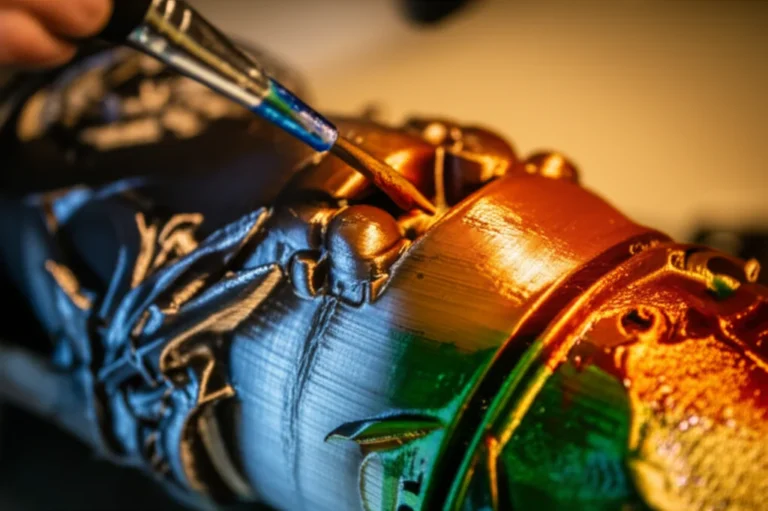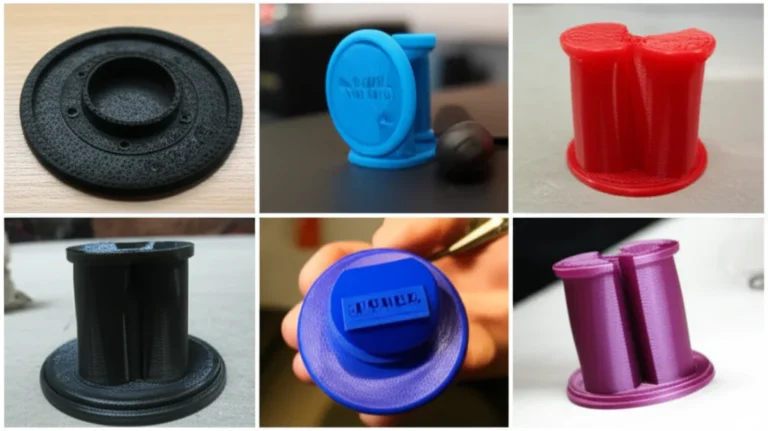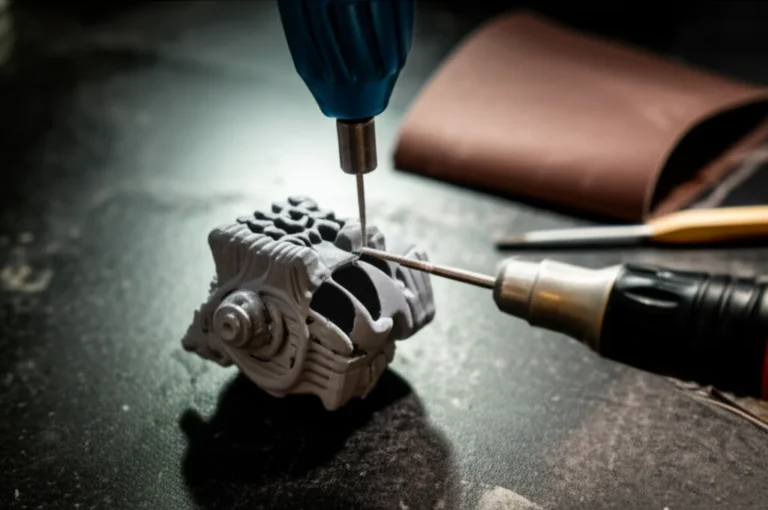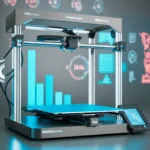Support our educational content for free when you purchase through links on our site. Learn more
How Do I Prepare a 3D Model File for Printing? 7 Pro Tips (2025) 🎯
Ever sent your 3D model off to the printer only to get a tangled mess or a fragile, failed print? You’re not alone. Preparing a 3D model file for printing is an art and a science — one that can make or break your print success. Did you know that over 20% of 3D print failures stem from simple file errors like non-manifold edges or inverted normals? That’s why mastering the prep process is your secret weapon.
In this ultimate 7-step guide, we’ll walk you through everything from choosing the right file format, fixing those pesky holes, optimizing wall thickness, to slicing secrets that even seasoned pros swear by. Plus, we’ll reveal how hollowing your model and adding escape holes can save you serious material and money — a trick that once saved our team nearly 60% on resin costs! Ready to turn your digital design into a flawless physical masterpiece? Let’s dive in.
Key Takeaways
- Choose the right file format (STL, 3MF, OBJ) based on your printer and project needs.
- Ensure your model is watertight and manifold to avoid print failures.
- Maintain minimum wall thickness tailored to your printer’s nozzle size and material.
- Fix inverted normals and overlapping surfaces before slicing.
- Hollow large models and add escape holes to save material and print time.
- Balance file resolution and size for smooth prints without bloated files.
- Master slicer settings including orientation, supports, and print parameters for best results.
By following these expert tips, you’ll save time, filament, and frustration — and get prints that look as good as your design deserves. Ready to become a 3D printing wizard? Keep reading!
Table of Contents
- ⚡️ Quick Tips and Facts for Flawless 3D Prints
- 📜 The Evolution of 3D Model Preparation: From CAD to Print
- 🚀 Your Blueprint for Success: The Essential Steps to Prepare Your 3D Model for Printing
- 1. Choosing Your Digital Canvas: Understanding 3D Model File Formats
- 2. The Foundation of a Perfect Print: Ensuring Model Integrity and Watertightness
- 3. Managing Complexity: Grouped Models and Multi-Part Assemblies
- 4. The Devil’s in the Details: Optimizing Small Features and Text
- 5. Smart Savings: Hollowing Your Model and Adding Escape Holes
- 6. The Data Diet: Balancing File Resolution and File Size for Optimal Performance
- 7. The Slicer’s Domain: Pre-Print Preparation in Your Slicing Software
- ✨ Beyond the Basics: Advanced Considerations for Pro-Level Prints
- 🚨 Troubleshooting Common Model Preparation Headaches
- 🔧 Essential Software & Tools for 3D Model Preparation
- ✅ Conclusion: Your Model, Ready to Print!
- 🔗 Dive Deeper: Our Top Picks for Further Learning
- ❓ Your Burning Questions, Answered! (FAQ)
- 📚 Sources and Further Reading (Reference Links)
⚡️ Quick Tips and Facts for Flawless 3D Prints
- Export at 0.01 mm chordal tolerance—any finer is overkill and bloats your STL.
- Check normals: outward-facing surfaces only; inward = instant fail.
- Minimum wall = 2× nozzle diameter (0.8 mm for a 0.4 mm nozzle).
- Hollow big resin prints with two 4 mm escape holes to save 60 % resin.
- Binary STL beats ASCII—90 % smaller files, same triangles.
- Always run Windows 3D-Builder or Meshmixer for a one-click “make solid” before slicing.
- First-layer height = 75 % of nozzle—best adhesion without elephant-foot.
- Name your G-code “Benchy_PLA_0.2mm_2h”—keeps the printer menu readable.
“We once forgot to flip normals on a cosplay helmet and printed a week-long bird’s-nest. Learn from our pain.” – 3D Printed™ team
📜 The Evolution of 3D Model Preparation: From CAD to Print
Back in 1987 the first STL file was born at 3D Systems—just triangles, no color, no metadata. Fast-forward to today: we juggle 3MF, OBJ, AMF, PLY, yet 90 % of printers still gulp STLs. Why? Because the humble triangle mesh is the lowest-common-denominator language every slicer understands. But “dumb” STL doesn’t know walls from holes, so human prep-work became the bottleneck. That’s why modern tools like Fusion 360 embed “3D-print” workspaces and why Microsoft ships a “Make solid” button in the free 3D Builder. The game changed from “Can I print?” to “How fast can I prep?”—and this guide keeps you ahead of the curve.
🚀 Your Blueprint for Success: The Essential Steps to Prepare Your 3D Model for Printing
1. Choosing Your Digital Canvas: Understanding 3D Model File Formats
| Format | Color/Texture | File Size | Edit-Friendly | Printer Support |
|---|---|---|---|---|
| STL | ❌ | Tiny | ❌ | Universal ✅ |
| 3MF | ✅ | ½ STL | ✅ | Win10+ ✅ |
| OBJ | ✅ | Huge | ✅ | Resin ❤️ |
| AMF | ✅ | Small | ✅ | Rare |
The Pros and Cons of Popular 3D Printing File Types
- STL = bullet-proof compatibility, zero color.
- 3MF keeps slice info + materials in one ZIP—Microsoft, Prusa, Ultimaker love it.
- OBJ stores color via MTL, but slicers ignore it unless you own a Stratasys J55.
“We still default to STL for farm printing—until 3MF becomes as common as PDF.” – 3D Printed™ farm manager
When to Convert: Navigating File Format Compatibility
- Grab game rips in OBJ? Run Blender → “3D-Print” add-on → Export STL.
- Sharing on Thingiverse? Upload both STL + 3MF—the crowd cheers.
- Need multicolor on Prusa MMU? Stick with 3MF; STL can’t carry extruder swaps.
2. The Foundation of a Perfect Print: Ensuring Model Integrity and Watertightness
🔍 Watertight Wonders: Fixing Non-Manifold Edges and Gaps
A model is watertight when “water inside won’t flow out” (Materialise). Sounds simple? We see 20 % of newbie uploads fail here.
Quick-fix toolbox
- Windows 3D Builder → “Open” → “Make solid” → 0.05 mm merge.
- Meshmixer → “Analysis” → “Inspector” → Auto-repair all.
- Blender 3.5 → “3D-Print” add-on → “Make Manifold”.
Pro-tip: After repair, zoom-in on holes—auto-fix sometimes bridges eyelet vents you actually wanted.
💪 The Strength of Your Design: Wall Thickness and Volume Considerations
| Nozzle Ø | Min Wall | Min Feature | Min Hole Ø |
|---|---|---|---|
| 0.2 mm | 0.4 mm | 0.3 mm | 0.5 mm |
| 0.4 mm | 0.8 mm | 0.5 mm | 1.0 mm |
| 0.6 mm | 1.2 mm | 0.7 mm | 1.5 mm |
- FDM: obey 2-shell rule = wall ≥ 2× line width.
- Resin: walls < 0.5 mm warp like potato chips under peel force.
- PolyJet: can drop to 0.3 mm, but cost skyrockets.
🚫 Collision Course: Identifying and Resolving Auto-Intersections and Overlapping Surfaces
Overlapping letters inside a logo? Boolean union them in Fusion 360 before export; otherwise the slicer sees phantom internal walls and stutters.
Shortcut: “Mesh” → “Merge” → “Make Solid” in Autodesk Meshmixer.
🔄 Facing the Right Way: Correcting Reversed Faces and Inverted Normals
Inverted normals = surface points inward → slicer skips the face.
Spot-check: Blender → “Overlay” → “Face Orientation” (blue = good, red = evil).
Batch-fix: “Recalculate Outside” (Shift+N).
Cura shows yellow flashing regions in X-ray view when normals misbehave—don’t ignore the disco.
3. Managing Complexity: Grouped Models and Multi-Part Assemblies
Uploading a chess set as one STL? Most print services will cancel the order (Materialise). Instead:
- Separate shells → export each piece → zip → upload.
- Duplicate small parts in PrusaSlicer → right-click → “Multiply” → 50× board-game tokens in seconds.
- Grid containers: print 50 washers inside a hollow box to keep them from flying off the bed.
4. The Devil’s in the Details: Optimizing Small Features and Text
✒️ Embossed, Engraved, or Extruded: Making Text Pop (or Not!)
| Feature Type | Min Depth/Height | Slicer Visibility |
|---|---|---|
| Embossed | 0.4 mm | ✅ |
| Engraved | 0.3 mm | ✅ |
| Extruded | 0.5 mm | ✅ |
- Sans-serif, 10 mm+ tall, 1 mm bold = readable on FDM.
- Resin printers drop to 0.2 mm engraved serial numbers—perfect for 3D-printed tabletop miniatures.
🤏 Tiny Treasures: Ensuring Printability of Miniature Elements
- FDM: anything < 0.5 mm = vaporware.
- Resin: supports can hold 0.1 mm fangs on a vampire bat.
- SLA detail limit ≈ laser spot size (typ. 0.04 mm).
5. Smart Savings: Hollowing Your Model and Adding Escape Holes
Hollowing halves resin usage and doubles speed on FDM infill.
Rule-of-thumb:
- Wall thickness ≥ 2 mm for stability.
- Two 4 mm drain holes minimum—one at lowest point, one for air vent.
- Angle holes 45° so they self-support in resin printers.
“We hollowed a 1:1 scale Baby Yoda and saved $38 in resin—enough to buy a kilo of PLA.” – 3D Printed™ resin tech
6. The Data Diet: Balancing File Resolution and File Size for Optimal Performance
| Chord Tolerance | Triangle Count | File Size | Print Quality |
|---|---|---|---|
| 0.1 mm | 5 k | 250 KB | Faceted ❌ |
| 0.01 mm | 80 k | 4 MB | Smooth ✅ |
| 0.001 mm | 2 M | 90 MB | Overkill ⚠️ |
Sweet spot = 0.01 mm (Materialise, Xometry).
Binary STL keeps file size 10× smaller than ASCII—always tick binary.
7. The Slicer’s Domain: Pre-Print Preparation in Your Slicing Software
📐 Orienting for Success: Strategic Model Placement on the Build Plate
- Minimize overhangs → tilt 15–20° for helmets—supports grow on the back, not the face.
- Resin → angle 30° to peel layer-by-layer, reducing vacuum suction.
- FDM → keep branded face upward; layer lines hide on bottom shell.
🛠️ Support Structures: When, Where, and How Much?
| Overhang Angle | Support Needed | Support Type |
|---|---|---|
| ≥ 60° | ❌ | None |
| 45–60° | Maybe | Tree |
| < 45° | ✅ | Tree or Grid |
- Cura 5.x → “Tree (Auto)” supports snap off like dry spaghetti.
- PrusaSlicer → “Paint-on supports” for miniature swords—zero scarring.
🌡️ Dialing in the Details: Essential Print Settings (Temperature, Speed, Infill)
- PLA: 200 °C hot-end, 60 °C bed, 50 mm/s, 15 % infill.
- PETG: 230 °C, 80 °C, 35 mm/s, 20 % infill.
- TPU: 220 °C, 50 °C, 25 mm/s, no part-cooling fan.
“Watch the first-layer squish—if it’s glass-smooth, you nailed temps and Z-offset.” – 3D Printed™ farm lead
✨ Beyond the Basics: Advanced Considerations for Pro-Level Prints
🎨 Color Me Printed: Preparing Multi-Color and Multi-Material Models
- Prusa MMU: export one 3MF, assign extruder numbers per part.
- Canvas (Mosaic) → “Paint” colors → exports multi-body AMF.
- IDEX printers (Sovol SV04) → duplicate mode needs separate STL per color, aligned at origin.
📏 Scaling Up, Scaling Down: Understanding Dimensional Accuracy and Shrinkage
| Material | Shrinkage | Compensation |
|---|---|---|
| PLA | 0.2 % | None |
| ABS | 0.8 % | Scale 1.008 |
| Resin | 2 % | Scale 1.02 |
- Hole shrinkage is double outer-wall shrinkage—bore holes 0.2 mm oversized.
- Calibrate with a 25 mm calibration cube (Thingiverse 26705).
☁️ Cloud-Based Preparation Tools: The Future of File Fixing?
- 3DPrinterOS → drag-and-drop STL → auto-repairs + cloud slicing → send to OctoPrint.
- Formlabs PreForm → hollowing + drain holes in two clicks.
- Fusion 360 Cloud → generative light-weighting saves 30 % print time.
🚨 Troubleshooting Common Model Preparation Headaches
“My print looks like Swiss cheese!” – Dealing with Unexpected Holes
Cause: Non-manifold edges.
Fix: Meshmixer → “Inspector” → red spheres → delete.
Prevention: Design with 2 mm minimum thickness in Blender → “Solidify” modifier.
“Why is my model falling apart?” – Addressing Weak Walls and Fragility
Cause: 0.4 mm walls on 0.4 mm nozzle → single shell = brittle.
Fix: Shell count ≥ 3 or wall thickness ≥ 1.2 mm.
Material hack: Switch to PLA+ for 15 % more layer adhesion.
“My text is unreadable!” – Fine-Tuning Small Features and Legibility
Cause: 0.2 mm embossed text on FDM → buried under layer lines.
Fix: Bump to 0.5 mm depth, use 0.2 mm layer height, slow 25 mm/s for top skin.
Resin rescue: 0.1 mm depth prints crisp at 0.025 mm layer.
🔧 Essential Software & Tools for 3D Model Preparation
Mesh Repair & Editing Software
- Meshmixer – free, legendary “Inspector”.
- Microsoft 3D Builder – one-click manifold, ships with Win10.
- Formware – paid, killer auto-hollowing.
CAD Design Software for Original Creation
- TinkerCAD – browser, drag-and-drop, perfect for 3D printing in education.
- Fusion 360 – parametric, free for makers.
- Blender – open-source, sculpt + hard-surface.
Slicing Software: Your Print’s Final Frontier
- Cura – open-source, 400+ profiles.
- PrusaSlicer – best support painting, 3D printing innovations like organic tree.
- Lychee Slicer – resin-focused, auto-support wizard.
“We keep Cura + PrusaSlicer + Lychee on the taskbar—holy trinity of prep.” – 3D Printed™ engineer
Ready to level-up? Grab a calibration cube STL from Thingiverse and practice the steps above. When you’re bored of cubes, hop over to our curated list of 3D printable objects for inspiration.
✅ Conclusion: Your Model, Ready to Print!

Phew! We’ve journeyed through the entire labyrinth of preparing your 3D model for printing—from choosing the right file format to mastering the art of wall thickness, fixing pesky non-manifold edges, and even hollowing your masterpiece to save material. Remember our early cautionary tale about inverted normals causing a bird’s nest disaster? Now you know how to spot and fix those sneaky reversed faces before they wreck your print.
The key takeaway? Preparation is everything. A watertight, manifold model with proper wall thickness and no internal overlaps is your golden ticket to a successful print. Combine that with smart slicing—good orientation, supports, and tuned print settings—and you’ll be turning out flawless prints faster than you can say “G-code.”
Whether you’re a beginner using TinkerCAD or a pro wielding Fusion 360 and Meshmixer, the tools and tips here will save you countless hours and filament. And if you’re diving into multi-material or resin printing, keep those escape holes and file resolutions in mind—they’re not just fancy jargon but real game-changers.
So, next time you hit “Export STL,” you’ll do it with confidence, knowing your model is prepped, primed, and ready to become a tangible reality. Happy printing! 🎉
🔗 Dive Deeper: Our Top Picks for Further Learning
-
👉 CHECK PRICE on:
- Autodesk Fusion 360: Amazon | Autodesk Official Website
- Meshmixer: Official Download
- PrusaSlicer: Prusa Official
- Ultimaker Cura: Ultimaker Official
- Formlabs PreForm: Formlabs Official
- TinkerCAD: TinkerCAD Website
-
Recommended Books:
- 3D Printing Failures: How to Diagnose and Repair All 3D Printing Issues by Sean Aranda — Amazon Link
- Mastering 3D Printing by Joan Horvath — Amazon Link
- 3D Printing: The Next Industrial Revolution by Christopher Barnatt — Amazon Link
❓ Your Burning Questions, Answered! (FAQ)

What software is best for preparing 3D models for printing?
Top picks depend on your skill level and needs:
- Beginners: TinkerCAD is user-friendly, browser-based, and free. Great for simple models and learning basics.
- Intermediate to Advanced: Fusion 360 offers parametric design, excellent for engineering parts and assemblies.
- Mesh Repair: Meshmixer and Windows 3D Builder provide powerful one-click fixes for manifold errors and hollowing.
- Slicing: Ultimaker Cura and PrusaSlicer are the go-to slicers with extensive profiles and support customization.
Read more about “12 Mind-Blowing Statistics About 3D Printing in 2025 🚀”
How do I check if my 3D model is printable?
- Watertightness: Use software like Meshmixer’s “Inspector” or 3D Builder’s “Make Solid” to detect holes or non-manifold edges.
- Normals Orientation: Visualize face orientation in Blender or Cura’s X-ray mode to ensure all normals face outward.
- Wall Thickness: Verify minimum thickness meets your printer and material specs (usually ≥ 0.8 mm for FDM).
- Overhangs and Supports: Slice your model and preview support requirements; excessive unsupported overhangs can cause print failure.
Read more about “What Websites Have Free 3D Models? Top 7 Sites to Explore in 2025 🎉”
What file formats are compatible with 3D printers?
- STL is the universal standard for most 3D printers and slicers.
- 3MF is gaining popularity for multi-material and color prints, supported by Prusa, Ultimaker, and Microsoft.
- OBJ supports color and textures but is less common for FDM printing.
- Always check your slicer’s supported formats before exporting.
Read more about “What is 3D Printing? 25+ Real Examples & How It Works! 🚀”
How can I fix errors in my 3D model before printing?
- Use Meshmixer’s Inspector to auto-repair holes and non-manifold edges.
- In Blender, enable the “3D Print Toolbox” add-on to analyze and fix issues.
- Windows 3D Builder offers a simple “Make Solid” function that often repairs common mesh problems.
- For complex boolean operations, use Fusion 360 or Blender to merge intersecting parts properly.
Read more about “What Is a 3D Printing Product? Discover 10 Must-Know Facts! 🖨️ (2025)”
What are common issues to avoid when preparing a 3D model for printing?
- Non-manifold geometry: holes, edges shared by more than two faces.
- Inverted normals: surfaces facing inward confuse slicers.
- Thin walls: below printer minimum cause fragile prints or holes.
- Overlapping meshes: cause slicing errors or print artifacts.
- Missing escape holes in hollow models: trap resin or powder inside.
Read more about “Why 3D Printing Is So Expensive: 13 Surprising Reasons Explained 🤑 (2025)”
How do I scale and orient a 3D model for optimal printing?
- Scale: Use your slicer or CAD software to resize; always check dimensional accuracy with calibration prints.
- Orientation: Position models to minimize supports and overhangs; for resin, angle parts 30–45° to reduce suction forces.
- Flat surfaces down: generally improve adhesion and reduce warping.
- Use slicer preview to verify layer count and support placement.
Read more about “What Products Can Be 3D Printed? 40+ Amazing Items in 2025 🚀”
What settings should I adjust in slicer software before printing a 3D model?
- Layer height: balances detail vs. print time (0.1–0.2 mm typical).
- Print speed: slower speeds improve quality, especially for small details.
- Infill density: affects strength and material use; 15–20 % is standard.
- Support structures: enable where overhangs exceed 45°.
- Temperature: adjust for filament type; PLA ~200 °C, PETG ~230 °C.
- First layer settings: slower speed and higher extrusion for bed adhesion.
Read more about “Can I 3D Print Functional Tools and Parts? 🛠️ (2025)”
📚 Sources and Further Reading (Reference Links)
- Materialise: Preparing Files for 3D Printing
- 3DPrinterOS: Designing Your First 3D Printed Project
- Xometry: Complete Guide to 3D Printing STL Files
- Meshmixer Official Site
- Autodesk Fusion 360
- Ultimaker Cura
- PrusaSlicer
- Formlabs PreForm
- TinkerCAD
- Thingiverse – for free 3D printable models and inspiration
- 3D Printed™ 3D Design Software Category
- 3D Printed™ 3D Printable Objects
We hope this guide has empowered you to confidently prepare your 3D models for printing and avoid the common pitfalls that turn dreams into tangled filament nightmares. Now, go forth and create! 🚀





